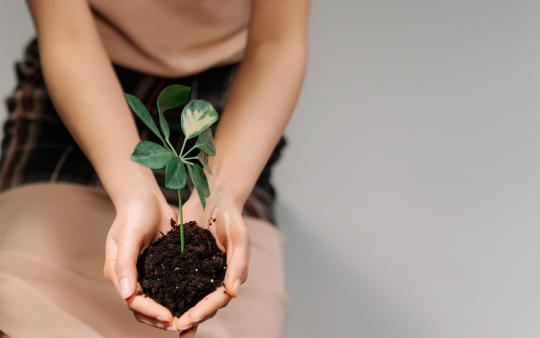Spring is in full swing, so I figured it would be a good time to sow some seeds of thought into readers about planting love. The Buddha suggested a four-part method of sharing love with the world. These ideas can be applied to all places, interactions, and experiences in our lives. This article will help you use the same steps mindfully as you think of your family meals. The original words for each step come from ancient teachings that were written in Sanskrit, so those words, followed by their closest English translations, are noted in the sections below. It’s a good time to think of these ideas as you plant your garden (if you’re a gardener), or share the ideas with your family and friends. If you live alone, you can also benefit from giving this loving attention to your food. We can all learn and benefit from mindfully understanding what exactly we are planting within, and around us. Once you’ve read each term for the loving actions, read on to see how each step—from planting to eating—can be filled with the ideas of these loving energies to cultivate happier gardening and/or eating.
“The people who give you their food give you their heart.”—Cesar Chavez
MAITRI
(translation: “loving kindness”)
This term means friendliness, goodwill, and active interest in the well-being of oneself and others.
Gardening Experience
Planting
Always begin by having loving kindness for the gardener who is planting the seeds or seedlings. This person is taking time and energy to help something grow. Repeat this affirmation: “May I be happy, healthy, safe, and live with ease.” This is the most well-known loving kindness affirmation to profess the appreciation of each individual person. Then, share this affirmation with each set of seeds or each plant that is being planted. Share the same wish of loving kindness with the seeds or plants by saying, “May this seed/plant be happy, healthy, safe, and live with ease.”
Growing
Think of a time when this same energy can be shared with the plant regularly. This could be each time you water the plant, or at a particular time of the day/week when you are checking in on your garden. Use the same affirmation. Kindly wish for the plant to be happy, healthy, safe, and to continue growing with ease. This is part of the foundation we can help create for the plants we grow.
Picking
As herbs, fruits, or vegetables are picked off your plant, send loving kindness to the rest of the plant as you wish it to stay happy, healthy, safe, and to continue to grow with ease. In the bustle of our day-to-day experiences, we may often rush away with the food from the plant that has faithfully grown for our benefit. Take a moment to extend some loving kindness for its continued efforts.
Preparing/Eating
The loving kindness here can be just a moment of pure appreciation for the food now contributing to your own health and happiness. Remember to start with sending loving kindness to yourself first, then to the food that is giving back its appreciation through nourishing you.
KARUNA
(translation: “compassion”)
Compassion involves a sympathetic concern for another. In gardening, we can have sympathetic concern for the plants. It is not uncommon for gardeners to feel concern if a plant is affected by frost if planted too early, or if it’s not doing well because of poor soil conditions, under/over-watering, or too much/too little sunlight. Most gardeners already unconsciously share compassion with their plants at such times. Those are the times they are most hopeful that the plant will survive and grow strong and healthy. But this can be done mindfully even before any such concern arises.
Gardening Experience
Planting
Share compassion for a new plant that is coming into a new space. It’s vulnerable and fully dependent on what, at this time, is quite unknown. Share compassion for its experience.
Growing
How exciting! Share compassion with the plant during this stage in its life. It’s now showing signs of the care it is receiving from the gardener(s), from the soil, sunlight, and the loving energy around it.
Picking
Share compassion with the plant for the work it has done to provide you with food for your body—what a journey it has had to get to this point—to benefit you and your family!
Preparing/Eating
Compassion here can be about recognizing that while one life is over (the food being picked), another (the one eating) is growing or surviving from the blessing of the life within this food. Recognize this life cycle with loving compassion and appreciation. This can be a great learning opportunity for kids and a good reminder for adults.

MUDITA
(translation: “sympathetic joy”)
Sympathetic joy is the sincere enthusiasm and excitement for another’s success. If you know you or your family members love gardening, you can share this experience with your plant(s) easily at each step. If this is not a natural joy for you, remember that whatever foods you eat came from some other person’s contribution to growing your meal. There is a joy in just knowing someone loves helping plants grow for you to survive, and if you are a gardener, the following details may help you plan to do this more mindfully.
Gardening Experience
Planting
How wonderful that new seeds or plants have found a new home with you. How happy these plants are in anticipation of growing into their fullest potential, and they get to feel your joyful energy as you are planting.
Growing
Think of a child that has just mastered a new skill, like standing, singing, or playing a new sport. Oh, they are so joyful for the accomplishment, and you are equally joyful to see the results of their efforts. Now, realize the same joy is happening for what you are growing. This is the plant’s entire reason for existence—to grow into its full self. What a joy to see it doing just that; feel the joy with your plant.
Picking
Imagine the ready-to-be-picked food shouting, “Pick me, pick me!” Feel the joy of this eagerness from your plant(s). Take a moment to appreciate the whole plant for its efforts to get to this point.
Preparing/Eating
Here again, you and your family can take a moment to truly appreciate the joy of a life fully lived. You happily give this life-giving food help, that in turn energizes you with the love-filled nutrients within.
“Nature does not hurry, yet everything is accomplished.”—Lao Tzu
UPEKSHA
(translation: “non-attachment, even-mindedness, letting go”)
We all know we lovingly let go of plants at the end of the growing season, but we can mindfully practice this loving energy throughout the growing season too.
Gardening Experience
Planting
When a seed or plant is planted into a container or into the ground, we know that there’s a process of letting go as we wait for the plant to grow in its own time. This can be an excellent exercise in building patience into our day-to-day experience; many people realize that this is often not easy to do. Be mindfully attentive right now, and you can see that plants are always modeling this patience for us. The plant is patiently waiting for the right time to grow.
Growing
The same type of plant may grow in one container and not in another, in only one part of the season, or with more or less watering than others. Bring a loving, even-mindedness to the plants and this awareness—some grow, some may not. It’s ok. Each can be loved for its own efforts as each is unique. This can be a wonderful mindfulness practice for understanding and loving each family member’s uniqueness too. Each is different, and each is loved.
Picking
Love each plant, whether you are picking edible fruits and vegetables or the dried leaves that need pruning. Each is doing its own part.
Preparing/Eating
Love the uniqueness of each plant and flavour (with equanimity), although our tastebuds may prefer one taste over another. Here’s another mindful-loving exercise to practice with loved ones: Appreciate each individual’s unique “flavour” (i.e., “attitude”) through the same mindful attention that you practice with food.
Your plants are going to love this attention, and you will feel the effects too! Enjoy this experience and feel the love.
You May Also Like: Friends in Low Places: Understanding Companion Planting, Cultivating a Sense-ible Spring Garden, Gardening for Absolute Beginners.






